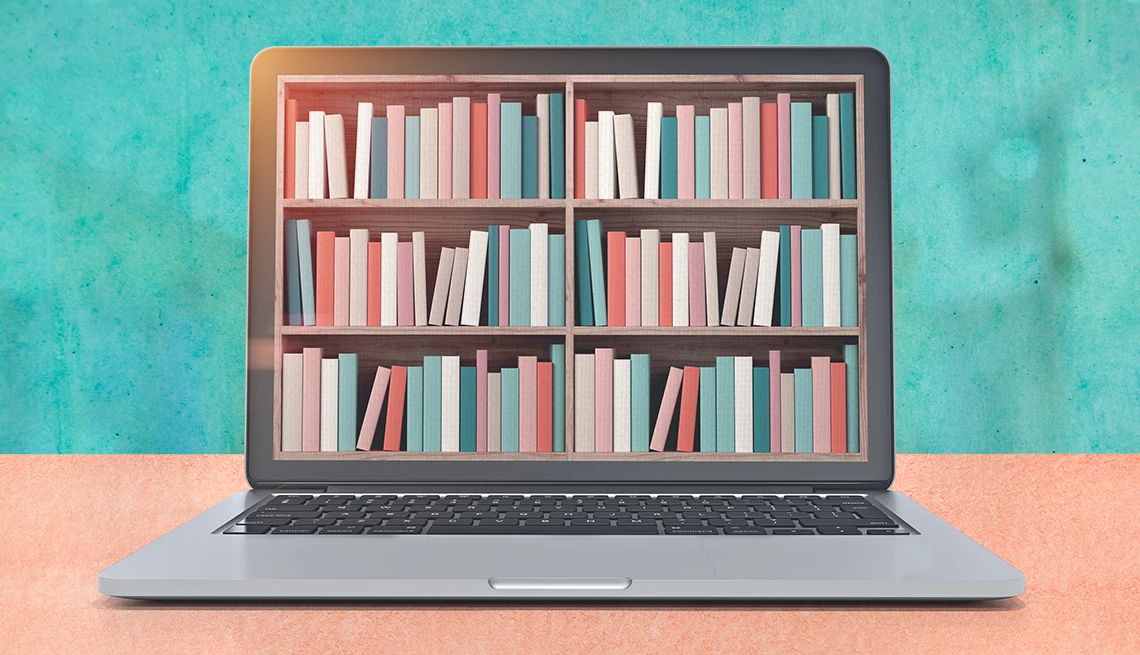AARP Hearing Center


E-reading has exploded in popularity since Amazon came out with its Kindle back in 2007, with e-book sales skyrocketing to $1 billion last year, according to the Association of American Publishers. .
The average newly released bestseller costs around $15 in e-book form. While that’s cheaper than the print version, the click-and-read habit still can get expensive — unless you take advantage of the thousands of e-books (print and audio!) that are free to borrow or download. Here’s where and how.
1. Public libraries
Libraries, as everyone knows, stack their shelves with physical books you can borrow for free, but many aren’t aware that they also fill their e-shelves with e-books (and audiobooks). Patrons can access them through digital databases, including the most popular one, Libby, which celebrated its 1 billionth publication checkout last year. (Others include CloudLibrary and Hoopla.)
How it works: To get started with Libby, you need a valid library card from a participating library. (Voracious readers feed their e-book habit by having multiple library cards.) Then download the Libby app and connect it to your library card, using the card’s PIN. Once connected, you can borrow e-books or audiobooks from your home library’s catalog. The e-books can be read within Libby or sent to a Kindle app or device. This direct-to-the-Kindle option is unique to Libby. Some newer models of Nook (Barnes and Noble’s e-reader) have Libby built in. For older models, users will have to transfer their Libby files from a desktop.
Hoopla is available through about 2,000 public library systems. Its app offers access to over 500,000 pieces of media, including e-books and movies, and works much like Libby, except files cannot be sent directly to a Kindle. Patrons love its deep bank of audiobooks.
CloudLibrary is a database similar to Libby and Hoopla that’s used in nearly 3,000 U.S. libraries worldwide. The CloudLibrary app is available for smartphones and tablets, either Apple or Android, and on computers. You can also download e-books on a computer to Nook and Kobo e-readers using a USB connection. It is not compatible with Kindle.
Pro tip
The Amazon-owned book community and recommendation site Goodreads.com includes a page with a wonderfully curated list of free e-books from various sources. The categories include silos like “Best FREE Science Fiction Audiobooks!” and “Best Permanently Free books.”
AARP Members Edition also offers free serialized versions of books by popular authors, including James Patterson, Mary Higgins Clark and Ann Cleeves.
2. Project Gutenberg
Gutenberg.org, a nonprofit, longtime keeper of online books, offers direct access to more than 70,000 e-books and a smaller number of audiobooks. They are all older works in the public domain, meaning they were published largely before 1929 and are no longer copyrighted. Gutenberg is a great place to access classics like Adventures of Huckleberry Finn or Moby Dick. It’s even better for big, fat books — think Don Quixote, available in Spanish or English — for which your reading time might exceed a library’s borrowing period.
How it works: No passwords or apps are required. The files can be read on a computer screen or downloaded and transferred to a device or phone with an e-reading app, like Kindle or Apple books. Alternatively, users can search Gutenberg’s listings directly from a phone or tablet, then download and open the book on the device itself.
Gutenberg has some general directions here.































































More From AARP
Check Out AARP’s Favorite Books of 2024 (So Far)
Our books editor shares her top pick and nine other fiction and nonfiction standoutsPreview: 28 of Summer’s Top Reads
Check out the season’s standout thrillers, mysteries, memoirs, beach reads and more
What to Read This Month and Other Book News
The month’s top novels, why we love Judy Blume, audiobooks (and Edoardo Ballerini) are hot, and more
Recommended for You